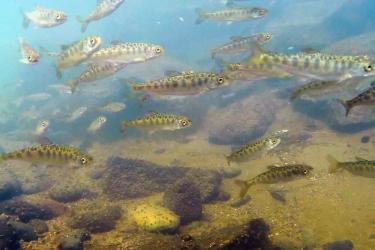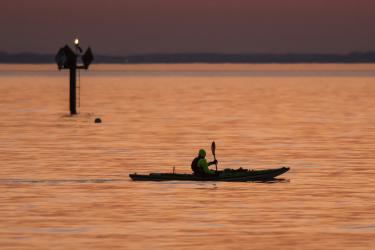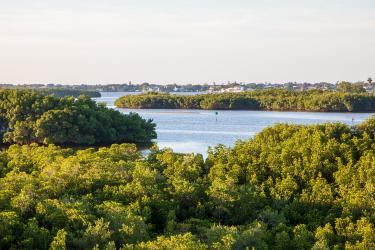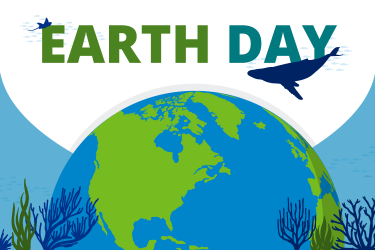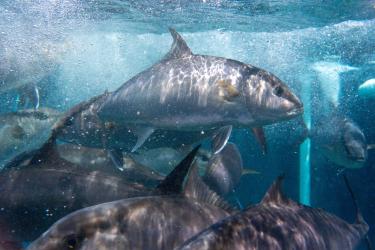NOAA protects and restores habitat to sustain fisheries, recover protected species, and maintain resilient coastal ecosystems and communities. Estuaries—where salty seawater mixes with fresh water draining from the land—are one of many coastal habitats we work in with our partners. Estuaries provide homes for fish and wildlife, support economies, fight climate change, and more.
1. Estuaries Are Nurseries of the Sea
Estuaries are often called the “nurseries of the sea,” because so many animals love to reproduce and spend the early part of their lives there. Most of the fish and shellfish we eat—including salmon, herring, crabs, and oysters—spend some or all of their life in estuaries. Estuaries provide habitat for about 68 percent of the United States’ commercial fish catch and 80 percent of recreational catch. On the West Coast, they also serve as critical nurseries for threatened and endangered juvenile salmon and steelhead making their transition from freshwater to the ocean. Estuaries are also a major stopover point for migratory animals such as waterfowl.
Bays, harbors, sounds, and other estuaries include habitats like marshes, mangroves, and seagrass beds. You might also find oyster reefs, kelp forests, and rocky or soft shorelines. Each of these habitats are populated with creatures that thrive in that setting. With so much variation, it’s no wonder that estuaries are among the most productive ecosystems on Earth.
2. Estuaries Help Us Fight Climate Change
We also love our planet, and estuaries play an important role in protecting communities from the impacts of climate
change. Salt marshes and seagrass beds serve as natural infrastructure. They can protect coastal communities from flooding and erosion by soaking up water and storm energy. Marshes, mangroves, and seagrass beds in estuaries capture and store carbon from greenhouse gasses—like carbon dioxide—from the atmosphere. This is known as coastal blue carbon.
Their ability to help fight climate change has economic value as well. NOAA partner Restore America’s Estuaries released a report focused on the economic value that estuaries provide by protecting communities from the impacts of flooding and climate change. It expands on their 2008 report The Economic and Market Value of Coasts and Estuaries: What’s at Stake? (PDF, 182 pages) which examined the benefits of protecting and restoring these important habitats.
3. Healthy Estuaries Help Support the Economy
Besides being a lovely home for fish and wildlife, coastal economies rely on estuaries for jobs, shipping, and commercial fishing. In the United States, estuaries are home to 39 percent of jobs and support 47 percent of economic output. In eight states, the estuary regions comprise 80 percent or more of the state’s economy.
One example is tourism. Tourists and residents visit estuaries to hunt and fish, watch birds, take photographs, hike, canoe and kayak, and observe wildlife. Tourism and recreation in coastal areas like estuaries contribute approximately $143 billion to the national economy each year. Ocean-based tourism and recreation industries employ nearly 2.5 million people. Coastal tourism jobs are also growing steadily, at a slightly higher rate than other economic sectors.
4. Estuaries are Homes For Humans, Too
With the amount of benefits they provide, it’s no surprise that people love estuaries. Twenty two of the 32 largest cities in the world are located on estuaries. Notable United States estuaries include the Chesapeake Bay, Puget Sound, and Tampa Bay.
Estuary regions comprise only 13 percent of the land area of the continental United States, but account for 40 percent of the population.
Along with that popularity comes challenges. Human activities on land can harm estuary health, degrading living conditions for species that live in or visit estuaries. Development pressures, pollution in runoff water, and other threats diminish the ecosystem and economic values of our estuaries. For example, more than a century of development on the West Coast has erased roughly 85 percent of the original estuarine wetlands there.
5. We Share Our Love for Estuaries with Others
It takes a village. Everything NOAA does to protect and restore estuaries requires strong partnerships. We work with local and state governments, other federal agencies, and other organizations to protect and restore estuaries. Each of us bring different strengths.
We use sound science and provide technical expertise to our partners, who provide additional funding and on-the-ground support. Together, our efforts sustain fisheries and recover protected species that call estuaries their home.
Some of our partners who work in estuaries on a national and regional scale include:
- Restore America’s Estuaries
- The Nature Conservancy
- Trout Unlimited
- Ducks Unlimited
- NOAA’s National Estuarine Research Reserves
Local partners include “friends of” groups, estuaries partnerships, and coastal advocacy organizations. We also work with tribal governments across the country to conserve habitat on tribal lands while respecting their history and culture.

